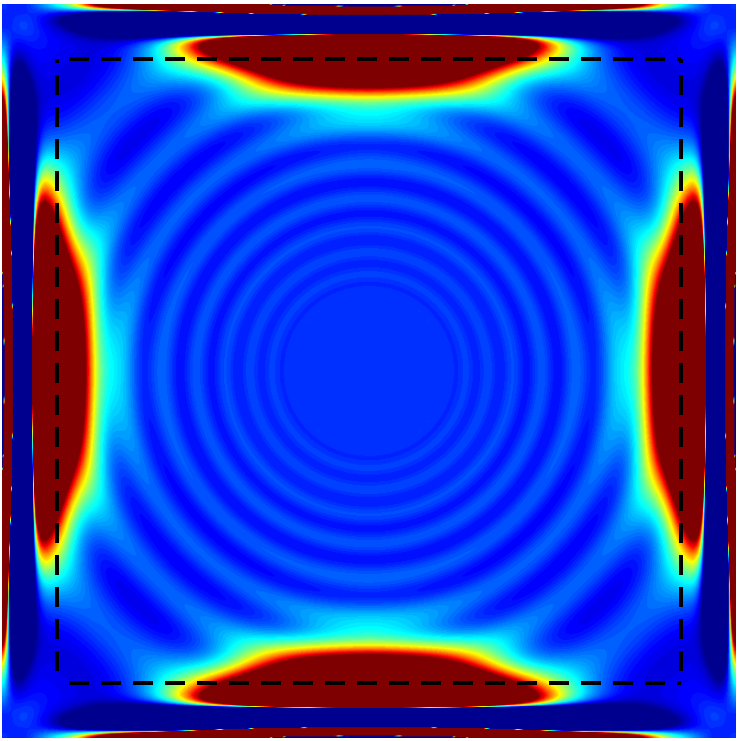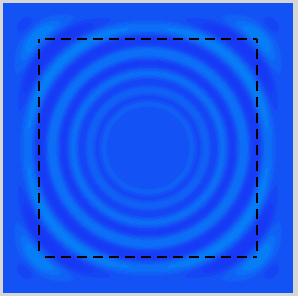Section: New Results
Absorbing boundary conditions and absorbing layers
New transparent boundary conditions for time harmonic acoustic and elastic problems in anisotropic media
Participants : Anne-Sophie Bonnet-Ben Dhia, Antoine Tonnoir, Sonia Fliss.
This topic is developed in collaboration with Vahan Baronian (CEA). Non destructive testing (NDT) is a common method to check the quality of structures and is widely used in industrial applications. Typically, in aircraft design, it is required to control structures like plates. Efficient and accurate numerical methods are required to simulate NDT experiments.
In our case, we want to study the diffraction of a time harmonic wave by a bounded defect in an infinite anisotropic elastic plate. The difficulty is to find a way to restrict the finite element computation to a small box containing the defect. Indeed classical methods such as the perfectly matched layers fail when the medium is anisotropic.
Up to now we considered the simpler case of an infinite dissipative 2D medium.
Our idea, inspired by the work of Sonia Fliss and Patrick Joly for periodic media, is to consider five domains recovering the whole plane:
-
a square that surrounds the defect in which we have a finite element representation of the solution,
-
and four half-spaces parallel to the four edges of the square, in which we can give an analytical representation of the solution thanks to the Fourier transform.
The different unknowns are coupled by well-chosen transmission relations which ensure the compatibility between the five representations.
The method has been validated successfully in the case of anisotropic acoustic media and the implementation for the case of elasticity is in progress. The mathematical properties of the formulation and the efficiency of the method strongly depend on the presence or not of overlaps between the finite element box and the four half-planes. The formulation with overlaps has good Fredholm properties but the well-posedness for all frequencies is proved only for the formulation without overlaps.
Perfectly Matched Layers in negative index metamaterials
Participants : Patrick Joly, Eliane Bécache, Valentin Vinoles.
The simulation of waves in unbounded domains requires methods to artificially truncate the computational domain. One of the most popular ones to do so is the Perfectly Matched Layers (PMLs) which are effective and stable for non dispersive isotropic media. For non dispersive anisotropic media, we established a necessary stability condition in 2004 : PMLs are unstable in presence of so called-backward waves.
We are interested here in dispersive media and more specifically in Negative Index Metamaterials (NIMs), also called left-handed media. Those media have negative permittivity and permeability at some frequencies due to microscopic resonating structures. Since the 1990s, NIMs are the subject of active researches due to their promising applications : superlens, cloaking, improved antenna, etc.
In a first step, we consider a simple model of NIMs : the Drude model. For this model, a plane wave analysis shows the simultaneous presence of both forward and backward waves and numerical simulations confirm the instability of standard PMLs (cf figure 2 ) that result from complex changes of variable leading to the following modification of the spatial derivatives
where and are the damping terms. Inspired by works of the physics community, we propose more general changes of variable
where is a function to be chosen judiciously. We have generalised the previous necessary stability condition for those new PMLs, called Stabilized Perfectly Matched Layers, for dispersive media. This analysis allows us to understand the instabilities observed for standard PMLs in NIMs and to propose a choice of functions which take into account the backward waves and stabilize the PMLs as confirmed by numerical simulations (cf figure 2 ).
Perfectly Matched Layers in plasmas
Participants : Patrick Joly, Eliane Bécache, Valentin Vinoles.
This work was done during the internship of Guillaume Chicaud in the framework of the ANR CHROME which concerns the study of electromagnetic wave propagation in plasmas. Our aim is to develop efficient and robust codes to simulate wave propagation in unbounded plasmas models. The simulation of waves in plasmas requires technics to bound the computational domain. As plasmas are dispersive media where backward waves may occur, the difficulties to construct stable PMLs are analogous to the ones encountered for Negative Index Metamaterials (cf 6.3.2 ). This work is a preliminary study of this topics, in a simplified model, the case of a 2D anisotropic uniaxial plasma. It consists first in analyzing the presence of backward waves with a plane wave analysis. The second step was to implement the equations using standard PMLs and to confirm the expected instabilities. Finally, we proposed stabilized PMLs (SPMLs), inspired by the work done in metamaterials (see section 6.3.2 ).
The continuation of this project will constitute the subject of the post-doc of Maryna Kachanovska.




